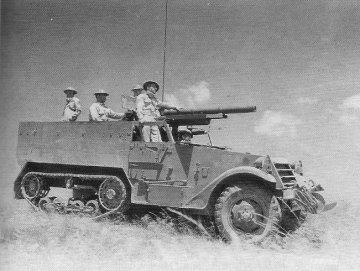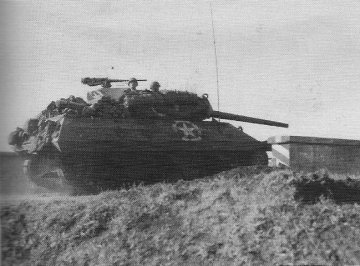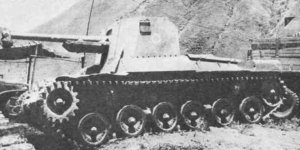![]() The Pacific War Online Encyclopedia
The Pacific War Online Encyclopedia
|
| Previous: Tanimoto Umataro | Table of Contents | Next: Tanks |
Tank destroyers are self-propelled antitank guns designed to
destroy enemy tanks. They were
experimented with by most of the major powers in the Second World War,
but were employed in large numbers primarily by the Germans and Americans.
Since "self-propelled antitank gun" is a pretty
good description of most tanks,
the concept of an antitank force distinct from the tank force was and
is controversial. In the United States, the Tank Destroyer Force was
created in response to the decisive penetration of Allied lines in France by German tank formations in
1940. Tank destroyer battalions
were to operate at the corps level
or higher as as a mobile "fire
brigade" to defeat such penetrations, leaving U.S. tank formations
free to create and exploit penetrations of enemy lines. However, the
notion of the decisive armor breakthrough was never really applicable
in the Pacific, where the terrain
was rarely suitable for large tank formations to make sweeping
maneuvers.

National Archives. Via Yeide (2007)
When war broke out in the Pacific, the only tank
destroyers in the hands of U.S. forces in the Philippines were fifty of
the M3
SPM. This was a halftrack carrying a
75mm gun that was hastily improvised to hold the line until the M10
could
be put
into production. The SPM was very
thinly armored (0.25 inch or 6mm) and its crew badly exposed when
firing the main gun. This gun could not safely traverse more than 21
degrees. The M3 was speedy at 45 miles per hour (72 km/h) on level
ground, but it had only a foot (30cm) of ground clearance. A
number were
employed in the South Pacific through 1943 and some may have seen
service as late as the Peleliu invasion.

National Archives. Via Yeide (2007)
The M10 was built on a tank chassis and resembled
a conventional tank, but with an open turret, lighter armor, superior
mobility, and a high-velocity 76mm gun. M10s eventually equipped the
five tank destroyer battalions that were deployed to the Pacific but
saw little combat.
Two of these battalions were later equipped
with the M18 Hellcat, which was built
on a chassis designed specifically for tank destroyers. The turret
mounted an even more powerful 76mm gun and had a remarkably fast power
traverse. The M18 was much lighter than the M10, giving it
phenomenal mobility (level speed 50 mph or 80 km/h) which was put to
good use in Europe, but this came at the cost of very thin armor
protection (half an inch or 13mm on the hull front). It saw
even less combat in the Pacific than the M-10.
The M36 Jackson, with its powerful 90mm armament, was not deployed to the Pacific prior to the surrender.

The Japanese were fearful of the combat power of American tanks and improvised their own tank destroyers to deal with them. The most important was the Type 1 Ho-ni, which put a 75mm gun on a tank chassis with an armored shield. Its gun was adequate but its mobility was limited, it had no machine guns for defense against enemy infantry, and only a few could be produced. A small number saw combat in the second Luzon campaign, but most were reserved for the defense of the home islands.
References
The Pacific War Online Encyclopedia © 2009-2010 by Kent G. Budge. Index